Highly Adaptive Reconfigurable Receiver Front-End for 5G and Satellite Applications
Abstract
1. Introduction
2. Highly Adaptive Reconfigurable Receiver Front-End (HARRF) for 5G and Satellite Applications
2.1. Conceptual Design Objectives
- High Linearity: Ensuring minimal distortion under high-power signal conditions.
- Low Noise Figure (NF): Optimising the sensitivity of the receiver.
- Adequate Gain: Maintaining sufficient signal amplification while minimising losses.
- Efficient Switching Mechanism: Seamless transition between X-band and K/Ka-band with minimal insertion loss.
- Wideband Operation: Supporting mmWave 5G FR2 applications with bandwidth flexibility.
2.2. Design Parameter Definitions
- Noise Figure (NF):
- Gain ():
- Linearity and Third-Order Intercept Point (IP3):
2.3. Design Process Flow
3. Switchable Receiver Front-End Architecture: HARRF LNA and SPDT Integration
3.1. Mathematical Model of the Receiver Frontend
- -
- represents the noise figure of each stage,
- -
- denotes the gain of the preceding stages.
3.2. Transmission Line Integration
- -
- is the transmission line impedance,
- -
- is the propagation constant,
- -
- l is the transmission line length.
3.3. Impedance Matching Between the Switch and the LNA
3.4. Impact on Noise Figure and Gain
4. Active Device Technology S-Parameter Extraction
4.1. I-V Characteristics of pHEMT Devices
4.2. Transconductance Characteristics
4.3. Reflection Coefficient and Matching Conditions
5. HARRF LNA Design
5.1. X-Band LNA Design Procedure
5.1.1. Stage-by-Stage Design Considerations
- Stage one: The first stage consists of a transistor of size , using inductive source feedback for stabilisation. This feedback helps bring the optimum noise match close to the gain match, thereby reducing the overall noise figure. The input source impedance is 50 , and the input matching network was implemented using an LC combination (series inductor and capacitor).
- Stage two: The second stage also employs a transistor of size . An inter-stage matching network is used between stages one and two to transform the output impedance of stage one to the input impedance of stage two. The goal is to provide the maximum stable gain and linearity while maintaining stability.
- Stage three: The final stage uses a transistor of size . The output of stage two is matched to the input of stage three to maximise the overall gain. A parallel feedback network is introduced in this stage to achieve gain flatness and to boost output power handling.
- Capacitors C1 and C10 act as DC blocks, preventing DC voltage from flowing along the RF path.
- Capacitors C2, C4, C5, C7, C8, and C9 are bypass or decoupling capacitors connected to the bias lines to reduce the coupling of RF signals into the power supply.
- Resistors R1, R3, and R5 are high-value resistors used to isolate RF signals from the DC supply.
- The input matching network for the first stage is formed by C1 and L1, ensuring that the amplifier sees at the transistor’s gate when terminated in 50 .
- The output matching network is composed of L6 and C10, allowing for proper load matching.
5.1.2. Noise Figure Design Considerations
5.1.3. X-Band LNA S-Parameter Analysis
5.1.4. State-of-the-Art in X-Band LNA Design
5.2. K/Ka-Band LNA Design Procedure
5.2.1. Stage-by-Stage Design Considerations
- Stage one: The first stage uses a pHEMT with inductive source feedback to achieve the optimum noise match () for the target frequency. The inter-stage matching network transforms the 50 input source impedance to the required noise match impedance.
- Stage two: The second stage also uses a pHEMT. The inter-stage matching network ensures that the output impedance of stage one is properly matched to the input impedance of stage two to maintain maximum stable gain.
- Stage three: A pHEMT is employed in the final stage to provide higher output power. Parallel feedback is introduced to enhance gain flatness across the entire band of operation.
- C1 and C11 serve as DC blocking capacitors, preventing DC currents from flowing along the RF path.
- C2, C4, C5, C7, C8, and C10 are power supply decoupling capacitors to isolate RF signals from the bias lines.
- R1, R3, and R5 are large-valued resistors that help in reducing RF coupling into the DC supply.
- The third stage employs a series RC feedback network (C9 and R6) to achieve the desired gain flatness.
- M1, M2, and M3 denote the pHEMT devices in stages one, two, and three, respectively.
5.2.2. K/Ka-Band LNA S-Parameter Analysis
5.2.3. Comparison with State-of-the-art K/Ka-Band LNAs
6. HARRF SPDT Design
6.1. FET Device Biasing
- ON State: Gate voltage . The low gate-source voltage produces a low channel resistance () and enables the RF signal to pass from drain to source.
- OFF State: Gate voltage . The transistor channel is pinched off, creating a high channel resistance (), thereby blocking the RF signal path.
6.2. Scattering Parameters (S-Parameters)
- is the reflection coefficient at port 1.
- , are the transmission coefficients from port 1 to ports 2 and 3, respectively.
- , represent the transmission from ports 2 and 3 back to port 1, respectively.
- is the reflection coefficient at port 2.
- is the reflection coefficient at port 3.
- , indicate the transmission between ports 2 and 3.
6.2.1. Network Power Relations
6.2.2. Integral Measures over Frequency
6.3. Incident and Reflected Waves
Power Consistency Check
6.4. Key Performance Metrics
6.4.1. Insertion Loss
6.4.2. Isolation
6.4.3. Return Loss
- Two series FETs to improve power handling and ensure operation down to DC.
- Four shunt-stacked FET units to enhance isolation by absorbing the off-state capacitance into a low-pass filter section.
6.5. Series vs. Shunt FET Configuration
- Series FETs: Used primarily to handle higher power and to lower the ON resistance. By stacking multiple FETs in series, the drain-source voltage across each FET is reduced, mitigating breakdown issues at high power levels or high operating voltages.
- Shunt FETs: These help improve isolation by providing an alternate low-impedance path to ground when they are turned ON (pinched-off for the main path). In the distributed design, the parasitic off-state capacitance of the shunt FETs can be absorbed into the matching network, effectively extending the bandwidth of operation.
7. Result Analysis of Wideband SPDT Switch and Reconfigurable Front-End
7.1. Comparison with State-of-the-Art Designs
7.2. SPDT Integration with X-Band ON and K/Ka-Band OFF
7.2.1. Gain Performance
7.2.2. Noise Performance
7.2.3. Reflection Coefficients
7.2.4. Stability
7.3. SPDT Integration with X-Band OFF and K/Ka-Band ON
7.3.1. Gain Performance
7.3.2. Noise Performance
7.3.3. Reflection Coefficients
7.3.4. Stability
8. Conclusions
Author Contributions
Funding
Data Availability Statement
Conflicts of Interest
References
- Paul, U.; Liu, J.; Troia, S.; Falowo, O.; Maier, G. Traffic-profile and machine learning based regional data center design and operation for 5G network. J. Commun. Netw. 2019, 21, 569–583. [Google Scholar]
- Uko, M.; Ekpo, S.; Elias, F.; Alabi, S. A 3.2–3.8 GHz low-noise amplifier for 5G/6G satellite-cellular convergence applications. e-Prime-Adv. Electr. Eng. Electron. Energy 2024, 8, 100559. [Google Scholar] [CrossRef]
- Uko, M.; Ekpo, S.C.; Enahoro, S.; Elias, F. Performance Optimization of 5G–Satellite Integrated Networks for IoT Applications in Smart Cities: A Two-Ray Propagation Model Approach. Smart Cities 2024, 7, 3895–3913. [Google Scholar] [CrossRef]
- Cisco. Cisco Annual Internet Report—Cisco Annual Internet Report (2018–2023) White Paper. 2022. Available online: https://www.cisco.com/c/en/us/solutions/collateral/executive-perspectives/annual-internet-report/white-paper-c11-741490.html (accessed on 14 March 2025).
- Bhagavatula, V. Exploring Multimode Cellular Transceiver Design: A Short Tutorial. IEEE Solid-State Circuits Mag. 2021, 13, 35–47. [Google Scholar] [CrossRef]
- Seth, S.; Kwon, D.H.; Venugopalan, S.; Son, S.W.; Zuo, Y.; Bhagavatula, V.; Lim, J.; Oh, D.; Cho, T.B. A Dynamically Biased Multiband 2G/3G/4G Cellular Transmitter in 28 nm CMOS. IEEE J. Solid-State Circuits 2016, 51, 1096–1108. [Google Scholar] [CrossRef]
- Hosseinian, M.; Choi, J.P.; Chang, S.H.; Lee, J. Review of 5G NTN standards development and technical challenges for satellite integration with the 5G network. IEEE Aerosp. Electron. Syst. Mag. 2021, 36, 22–31. [Google Scholar]
- Völk, F.; Schlichter, T.; Kaltenberger, F.; Heyn, T.; Casati, G.; Schwarz, R.T.; Knopp, A. Field trial of a 5G non-terrestrial network using OpenAirInterface. IEEE Open J. Veh. Technol. 2022, 3, 243–250. [Google Scholar] [CrossRef]
- Pastukh, A.; Tikhvinskiy, V.; Dymkova, S.; Varlamov, O. Challenges of Using the L-Band and S-Band for Direct-to-Cellular Satellite 5G-6G NTN Systems. Technologies 2023, 11, 110. [Google Scholar] [CrossRef]
- Manco, J.; Dayoub, I.; Nafkha, A.; Alibakhshikenari, M.; Thameur, H.B. Spectrum sensing using software defined radio for cognitive radio networks: A survey. IEEE Access 2022, 10, 131887–131908. [Google Scholar]
- Tuninato, R.; Garello, R. 5G NTN Primary Synchronization Signal: An Improved Detector for Handheld Devices. IEEE Open J. Commun. Soc. 2024, 5, 3792–3803. [Google Scholar]
- Rappaport, T.S.; Xing, Y.; MacCartney, G.R.; Molisch, A.F.; Mellios, E.; Zhang, J. Overview of Millimeter Wave Communications for Fifth-Generation (5G) Wireless Networks—With a Focus on Propagation Models. IEEE Trans. Antennas Propag. 2017, 65, 6213–6230. [Google Scholar] [CrossRef]
- LaRocca, T.R.; Thai, K.; Snyder, R.; Jai, R.; Kultran, D.; Fordham, O.; Wu, B.Y.C.; Yang, Y.; Watanabe, M.K.; Rodgers, P.; et al. Secure Satellite Communication Digital IF CMOS Q-Band Transmitter and K-Band Receiver. IEEE J. Solid-State Circuits 2019, 54, 1329–1338. [Google Scholar] [CrossRef]
- Boccardi, F.; Heath, R.W.; Lozano, A.; Marzetta, T.L.; Popovski, P. Five disruptive technology directions for 5G. IEEE Commun. Mag. 2014, 52, 74–80. [Google Scholar] [CrossRef]
- Uko, M.; Ekpo, S. 8–12 GHz pHEMT MMIC Low-Noise Amplifier for 5G and Fiber-Integrated Satellite Applications. Int. Rev. Aerosp. Eng. (IREASE) 2020, 13, 99. [Google Scholar] [CrossRef]
- Ekpo, S.; George, D. 4–8 GHz LNA design for a Highly Adaptive Small Satellite Transponder using InGaAs pHEMT Technology. In Proceedings of the 2010 IEEE 11th Annual Wireless and Microwave Technology Conference (WAMICON), Melbourne, FL, USA, 12–13 April 2010; pp. 1–4. [Google Scholar] [CrossRef]
- Ekpo, S.C.; George, D. Impact of Noise Figure on a Satellite Link Performance. IEEE Commun. Lett. 2011, 15, 977–979. [Google Scholar] [CrossRef]
- Uko, M.; Ekpo, S. A 23–28 GHz pHEMT MMIC Low-Noise Amplifier for Satellite-Cellular Convergence Applications. Int. Rev. Aerosp. Eng. J. 2021, 14, 1–10. [Google Scholar]
- Bhaumik, S.; Kettle, D. Broadband X-band low noise amplifier based on 70 nm GaAs metamorphic high electron mobility transistor technology for deep space and satellite communication networks and oscillation issues. IET Microw. Antennas Propag. 2010, 4, 1208–1215. [Google Scholar] [CrossRef]
- Nikbakhsh, M.R.; Abiri, E.; Ghasemian, H.; Salehi, M.R. Two-stage current-reused variable-gain low-noise amplifier for X-band receivers in 65 nm complementary metal oxide semiconductor technology. IET Circuits Devices Syst. 2018, 12, 630–637. [Google Scholar]
- Davulcu, M.; Çalişkan, C.; Kalyoncu, I.; Gurbuz, Y. An X-Band SiGe BiCMOS Triple-Cascode LNA With Boosted Gain and P1dB. IEEE Trans. Circuits Syst. II Exp. Briefs 2018, 65, 994–998. [Google Scholar] [CrossRef]
- Nam, H.; Nguyen, V.V.; Trinh, V.S.; Song, J.M.; Lee, B.H.; Park, J.D. A Full X-Band Phased-Array Transmit/Receive Module Chip in 65-nm CMOS Technology. IEEE Access 2020, 8, 76182–76192. [Google Scholar] [CrossRef]
- Çağlar, A.; Yelten, M.B. A 180-nm X-Band Cryogenic CMOS LNA. IEEE Microw. Wirel. Components Lett. 2020, 30, 395–398. [Google Scholar] [CrossRef]
- Abelan, B.A.; Seelmann-Eggebert, M.; Bruch, D.; Leuther, A.; Massler, H.; Baldischweiler, B.; Schlechtweg, M.; Gallego-Puyol, J.D.; Lopez-Fernandez, I.; Diez-Gonzalez, C.; et al. 4–12 and 25–34 GHz Cryogenic mHEMT MMIC Low-Noise Amplifiers. IEEE Trans. Microw. Theory Tech. 2012, 60, 4080–4088. [Google Scholar] [CrossRef]
- Cha, E.; Wadefalk, N.; Nilsson, P.; Schleeh, J.; Moschetti, G.; Pourkabirian, A.; Tuzi, S.; Grahn, J. 0.3–14 and 16–28 GHz Wide-Bandwidth Cryogenic MMIC Low-Noise Amplifiers. IEEE Trans. Microw. Theory Tech. 2018, 66, 4860–4869. [Google Scholar] [CrossRef]
- Tabarani, F.; Boccia, L.; Purtova, T.; Shamsafar, A.; Schumacher, H.; Amendola, G. 0.25-μm BiCMOS System-on-Chip for K-/Ka-Band Satellite Communication Transmit–Receive Active Phased Arrays. IEEE Trans. Microw. Theory Tech. 2018, 66, 2325–2339. [Google Scholar] [CrossRef]
- Pang, J.; Li, Z.; Kubozoe, R.; Luo, X.; Wu, R.; Wang, Y.; You, D.; Fadila, A.A.; Saengchan, R.; Nakamura, T.; et al. A 28-GHz CMOS Phased-Array Beamformer Utilizing Neutralized Bi-Directional Technique Supporting Dual-Polarized MIMO for 5G NR. IEEE J. Solid-State Circuits 2020, 55, 2371–2386. [Google Scholar] [CrossRef]
- Kim, H.T.; Park, B.S.; Song, S.S.; Moon, T.S.; Kim, S.H.; Kim, J.M.; Chang, J.Y.; Ho, Y.C. A 28-GHz CMOS Direct Conversion Transceiver With Packaged 2 × 4 Antenna Array for 5G Cellular System. IEEE J. Solid-State Circuits 2018, 53, 1245–1259. [Google Scholar] [CrossRef]
- Sadhu, B.; Tousi, Y.; Hallin, J.; Sahl, S.; Reynolds, S.K.; Renström, O.; Sjogren, K.; Haapalahti, O.; Mazor, N.; Bokinge, B.; et al. A 28-GHz 32-Element TRX Phased-Array IC With Concurrent Dual-Polarized Operation and Orthogonal Phase and Gain Control for 5G Communications. IEEE J. Solid-State Circuits 2017, 52, 3373–3391. [Google Scholar] [CrossRef]
- Wang, Y.; You, D.; Fu, X.; Nakamura, T.; Fadila, A.A.; Someya, T.; Kawaguchi, A.; Qiu, J.; Pang, J.; Yanagisawa, K.; et al. A Ka-Band SATCOM Transceiver in 65-nm CMOS With High-Linearity TX and Dual-Channel Wide-Dynamic-Range RX for Terrestrial Terminal. IEEE J. Solid-State Circuits 2022, 57, 356–370. [Google Scholar] [CrossRef]
- Uchida, H.; Takatsu, S.; Nakahara, K.; Katoh, T.; Itoh, Y.; Imai, R.; Yamamoto, M.; Kadowaki, N. Ka-band multistage MMIC low-noise amplifier using source inductors with different values for each stage. IEEE Microw. Guid. Wave Lett. 1999, 9, 71–72. [Google Scholar] [CrossRef]
- Ekpo, S.; Kharel, R.; Uko, M. A Broadband LNA Design in Common-Source Configuration for Reconfigurable Multi-standards Multi-bands Communications. In Proceedings of the 2018 ARMMS RF and Microwave Conference, Thame, UK, 23–24 April 2018; pp. 1–10. [Google Scholar]
- Nikandish, G.; Yousefi, A.; Kalantari, M. A Broadband Multistage LNA With Bandwidth and Linearity Enhancement. IEEE Microw. Wirel. Components Lett. 2016, 26, 834–836. [Google Scholar] [CrossRef]
- Ma, Q.; Leenaerts, D.M.W.; Baltus, P.G.M. Silicon-Based True-Time-Delay Phased-Array Front-Ends at Ka-Band. IEEE Trans. Microw. Theory Tech. 2015, 63, 2942–2952. [Google Scholar] [CrossRef]
- Elkholy, M.; Shakib, S.; Dunworth, J.; Aparin, V.; Entesari, K. A Wideband Variable Gain LNA With High OIP3 for 5G Using 40-nm Bulk CMOS. IEEE Microw. Wirel. Components Lett. 2018, 28, 64–66. [Google Scholar] [CrossRef]
- Zafar, M.; Ekpo, S.; George, J.; Sheedy, P.; Uko, M.; Gibson, A. Hybrid power divider and combiner for passive RFID tag wireless energy harvesting. IEEE Access 2021, 10, 502–515. [Google Scholar]
- Lin, K.-Y.; Wang, Y.-J.; Niu, D.-C.; Wang, H. Millimeter-wave MMIC single-pole-double-throw passive HEMT switches using impedance-transformation networks. IEEE Trans. Microw. Theory Tech. 2003, 51, 1076–1085. [Google Scholar] [CrossRef]
- Ayasli, Y. Microwave switching with GaAs FETs. Microw. J. 1982, 25, 61–64. [Google Scholar]
- Kim, J.; Park, J.; Kim, J. 28 GHz common-leg T/R IC in 65 nm CMOS technology. Electron. Lett. 2018, 54, 616–618. [Google Scholar] [CrossRef]
- Fang, W.; Chen, C.; Lin, Y. 2.4-GHz Absorptive MMIC Switch for Switched Beamformer Application. IEEE Trans. Microw. Theory Tech. 2017, 65, 3950–3961. [Google Scholar] [CrossRef]
- Zobilah, A.M.; Zakaria, Z.; Shairi, N.A. Selectable Multiband Isolation of Single Pole Double Throw Switch using Transmission Line Stub Resonator for WiMAX and LTE Applications. IET Microw. Antennas Propag. 2017, 11, 844–851. [Google Scholar] [CrossRef]
- Nguyen, D.P.; Pham, A.; Aryanfar, F. A K-Band High Power and High Isolation Stacked-FET Single Pole Double Throw MMIC Switch Using Resonating Capacitor. IEEE Microw. Wirel. Components Lett. 2016, 26, 696–698. [Google Scholar] [CrossRef]
- Ekpo, S.C.; Adebisi, B.; Wells, A. Regulated-element frost beamformer for vehicular multimedia sound enhancement and noise reduction applications. IEEE Access 2017, 5, 27254–27262. [Google Scholar]
- Rao, C.V.N.; Ghodgaonkar, D.K.; Sharma, N. GaAs MMIC Low Noise Amplifier With Integrated High-Power Absorptive Receive Protection Switch. IEEE Microw. Wirel. Components Lett. 2018, 28, 1128–1130. [Google Scholar] [CrossRef]
- Hieda, M.; Nakahara, K.; Miyaguchi, K.; Kurusu, H.; Iyama, Y.; Takagi, T.; Urasaki, S. High-isolation series-shunt FET SPDT switch with a capacitor canceling FET parasitic inductance. IEEE Trans. Microw. Theory Tech. 2001, 49, 2453–2458. [Google Scholar] [CrossRef]
- Ekpo, S. Thermal subsystem operational times analysis for ubiquitous small satellites relay in LEO. Int. Rev. Aerosp. Eng. (IREASE) 2018, 11, 48–57. [Google Scholar] [CrossRef]
- Erturk, V.; Gurdal, A.; Ozbay, E. A High-Power and Broadband GaN SPDT MMIC Switch Using Gate-Optimized HEMTs. IEEE Microw. Wirel. Technol. Lett. 2023, 33, 1207–1210. [Google Scholar]
- Campbell, C.F.; Dumka, D.C. Wideband high power GaN on SiC SPDT switch MMICs. In Proceedings of the 2010 IEEE MTT-S International Microwave Symposium, Anaheim, CA, USA, 23–28 May 2010; pp. 145–148. [Google Scholar]
- D’Angelo, S.; Biondi, A.; Scappaviva, F.; Resca, D.; Monaco, V.A. A GaN MMIC chipset suitable for integration in future X-band spaceborne radar T/R module Frontends. In Proceedings of the 2016 21st International Conference on Microwave, Radar and Wireless Communications (MIKON), Krakow, Poland, 9–11 May 2016; pp. 1–4. [Google Scholar]
- Memioglu, O.; Turan, D.I.; Kocer, F.; Civi, O.A. A High Power, GaN, Quarter-Wave Length Switch for X-Band Applications. In Proceedings of the 2018 18th Mediterranean Microwave Symposium (MMS), Istanbul, Turkey, 31 October–2 November 2018; pp. 195–197. [Google Scholar]
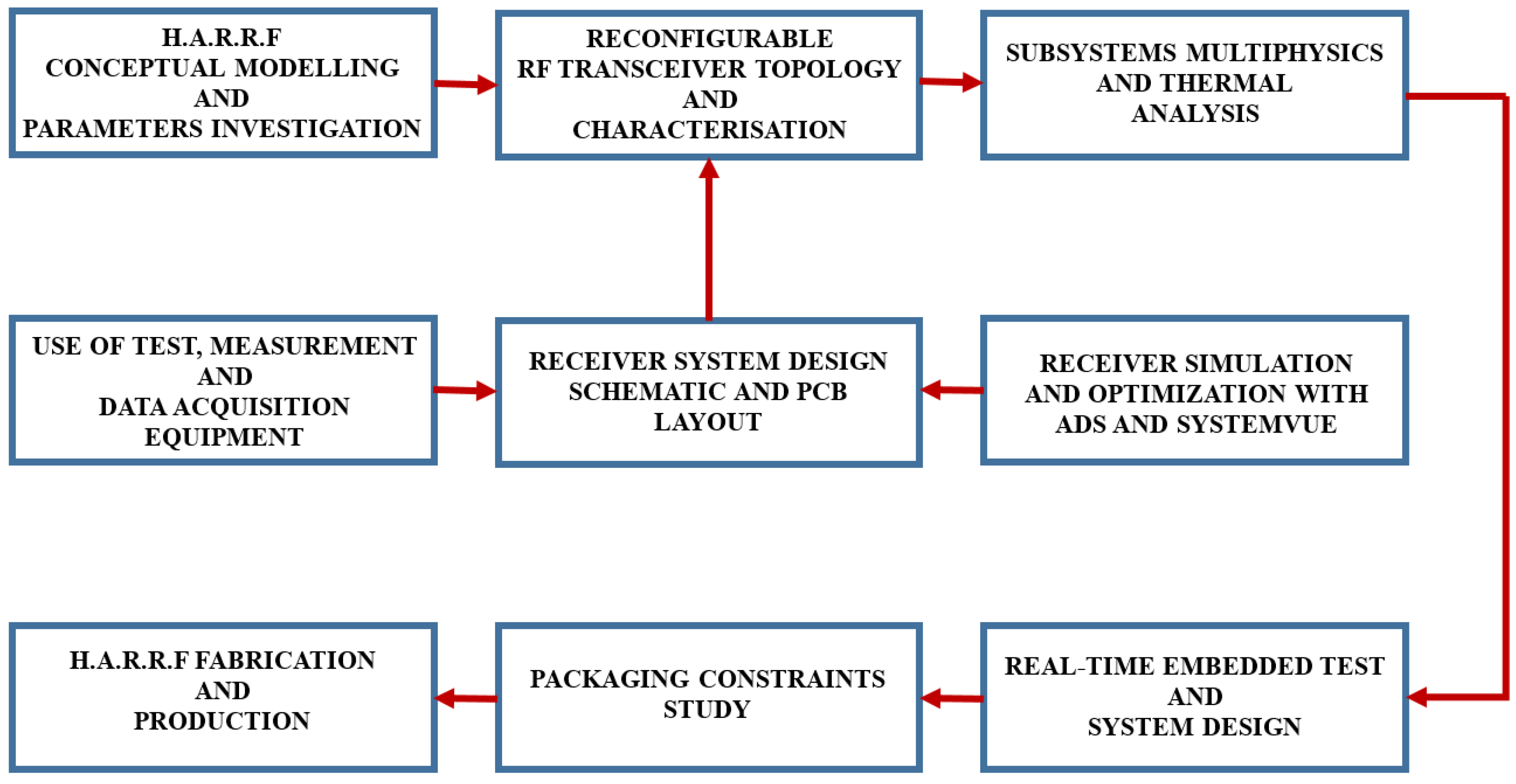
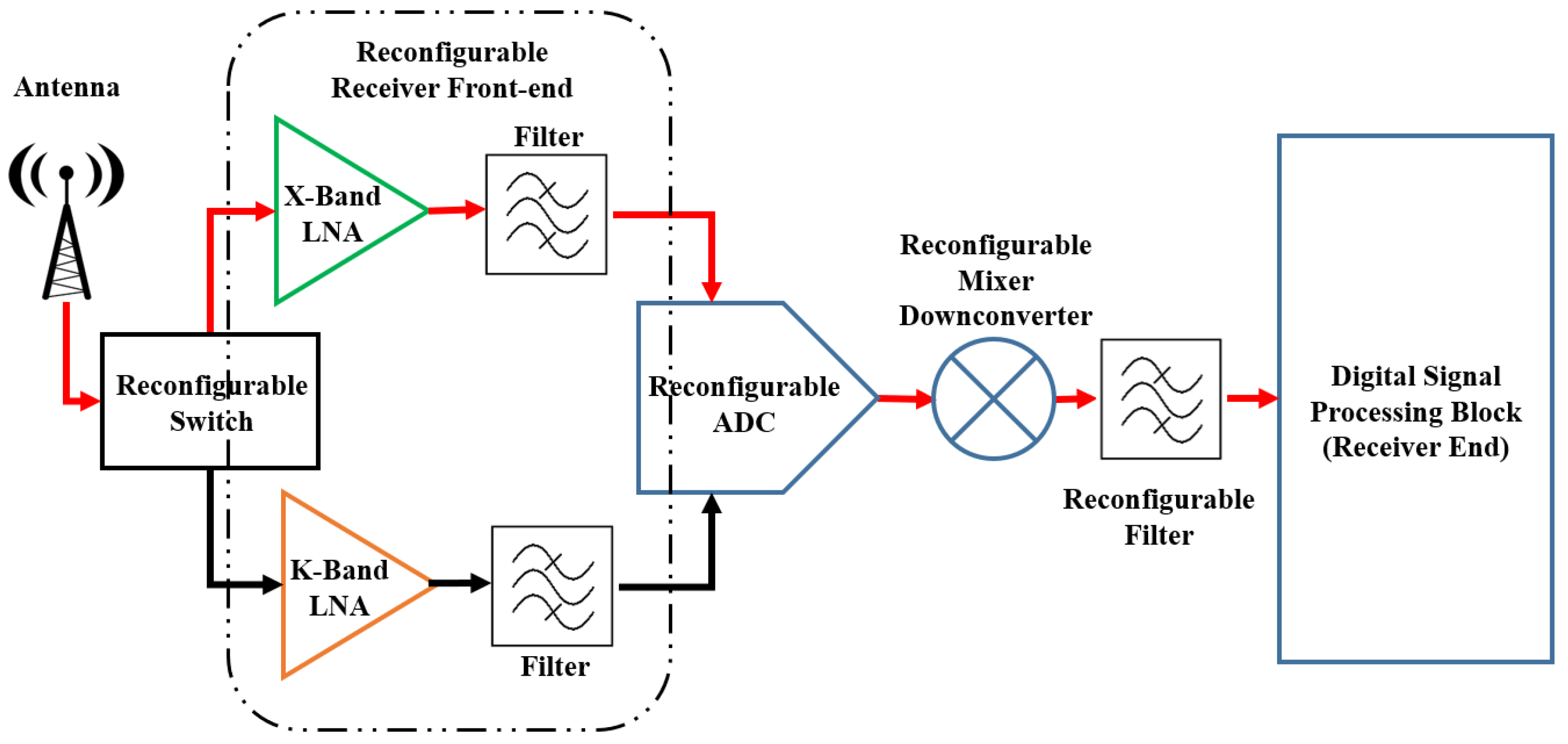


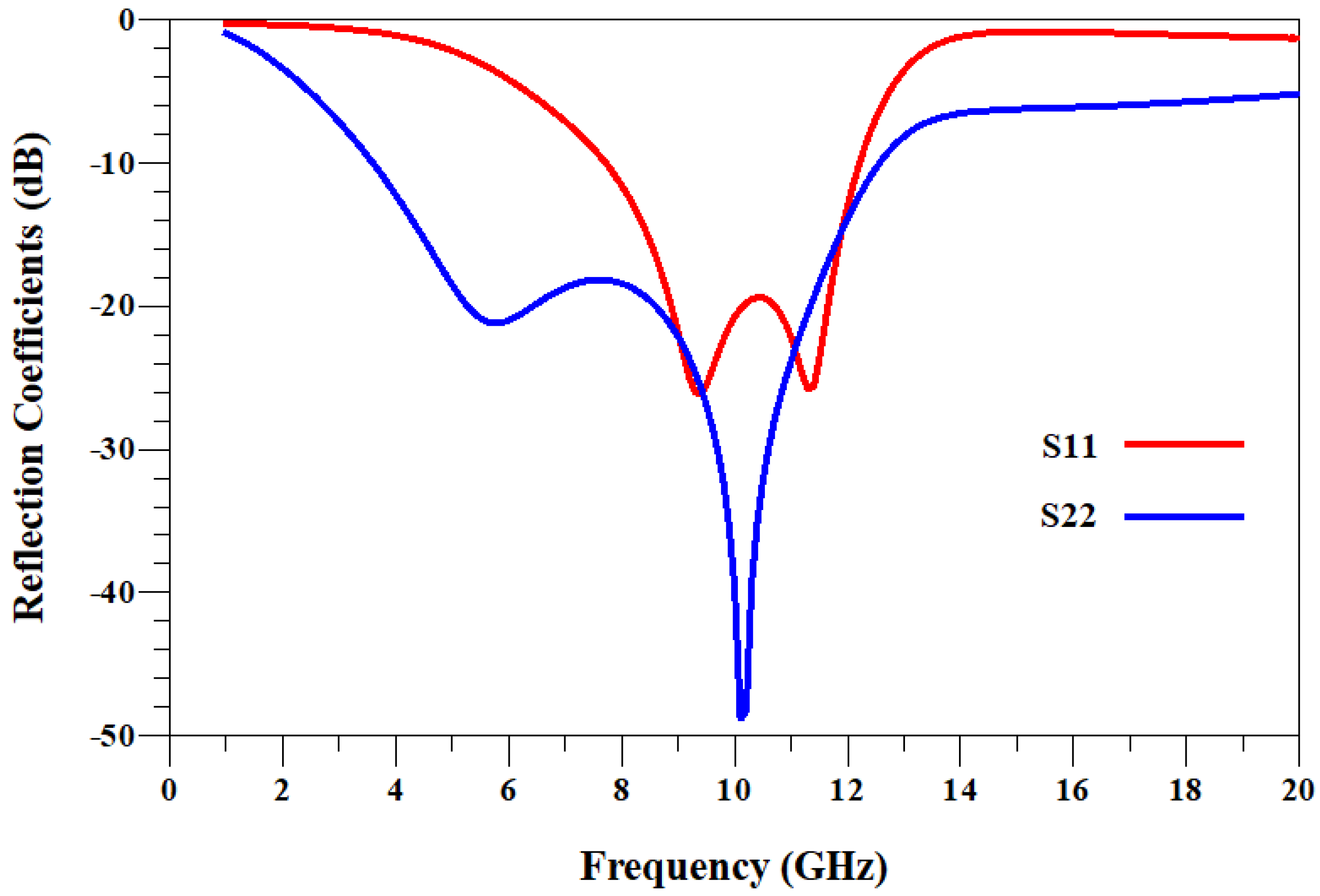

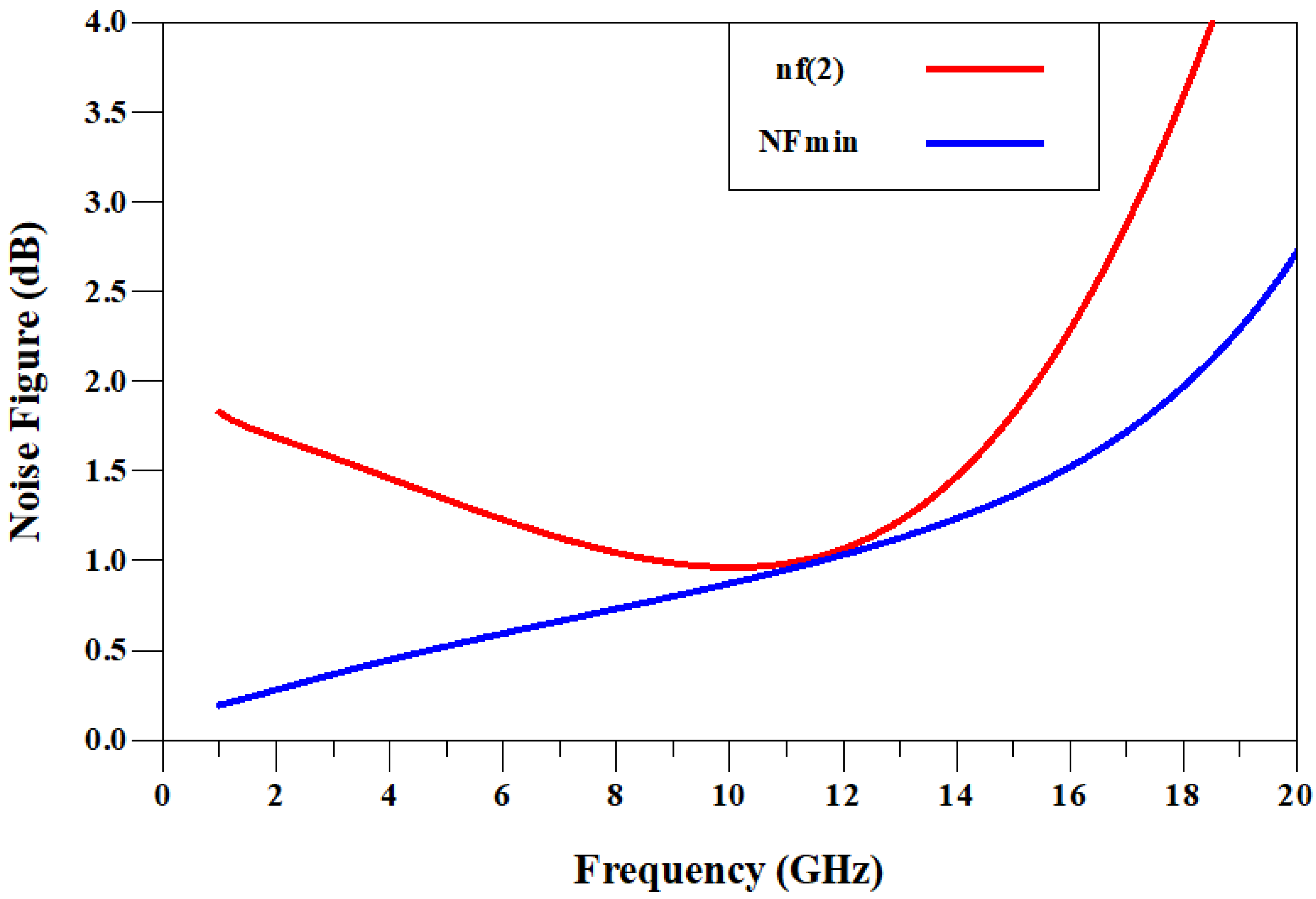


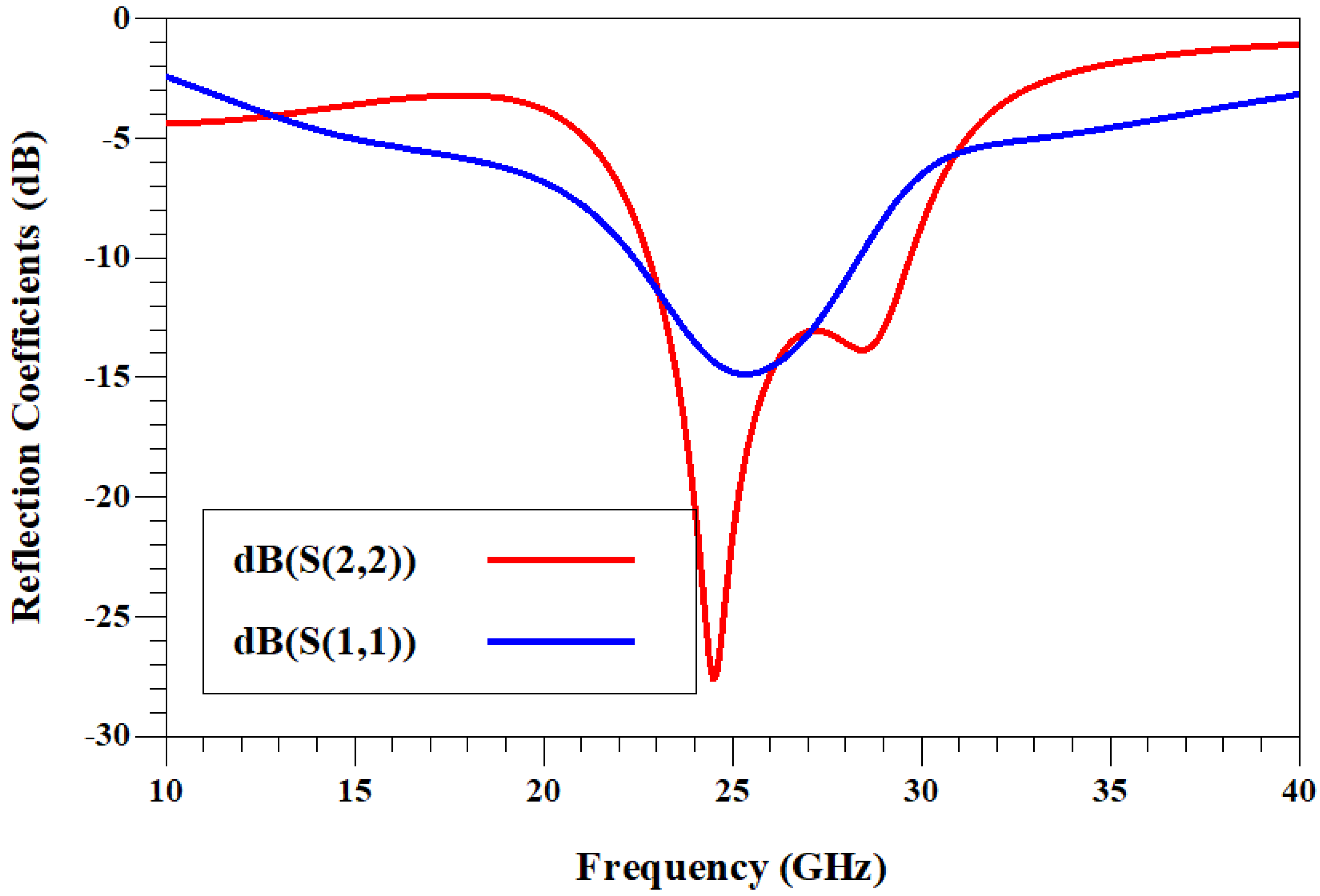


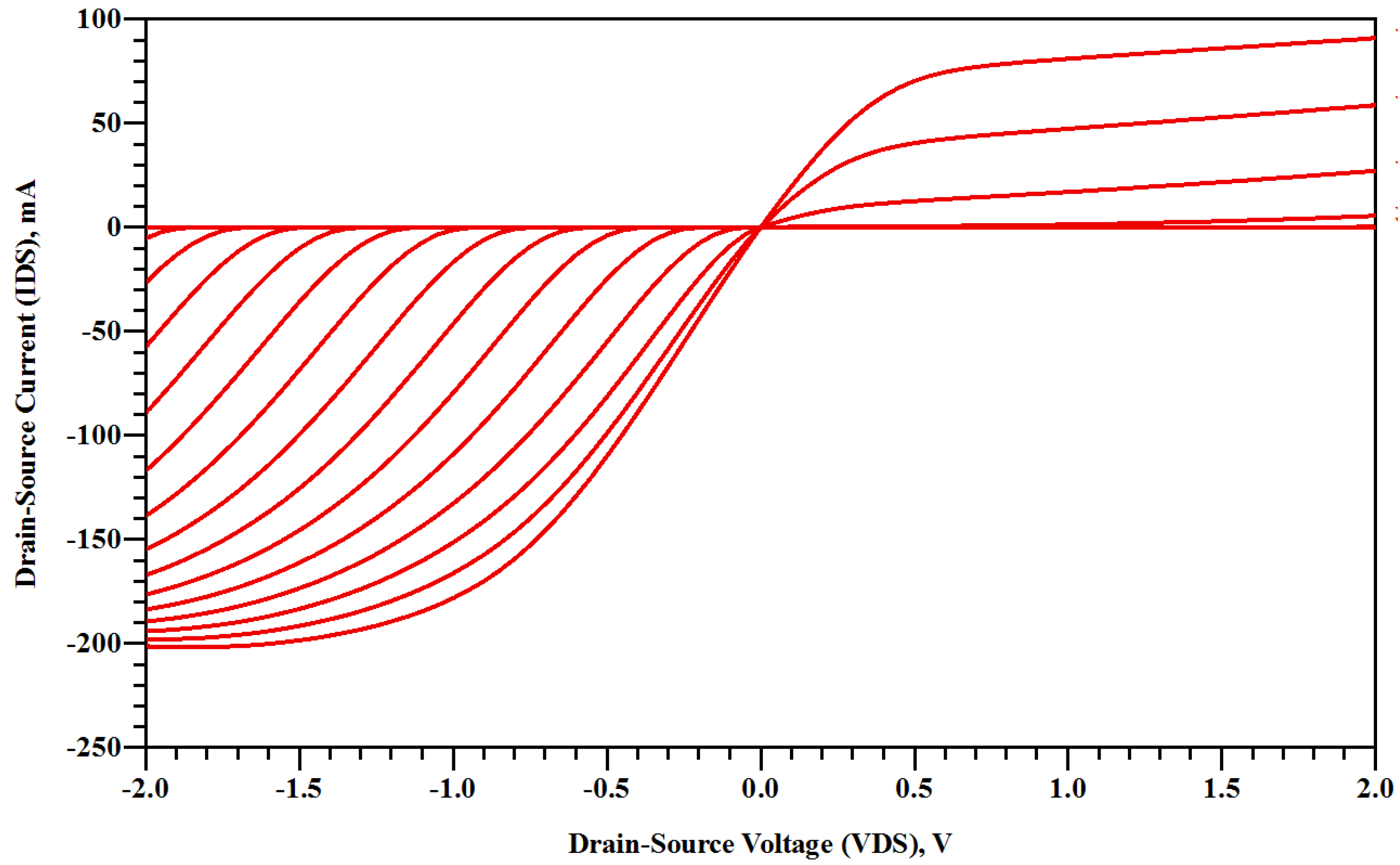
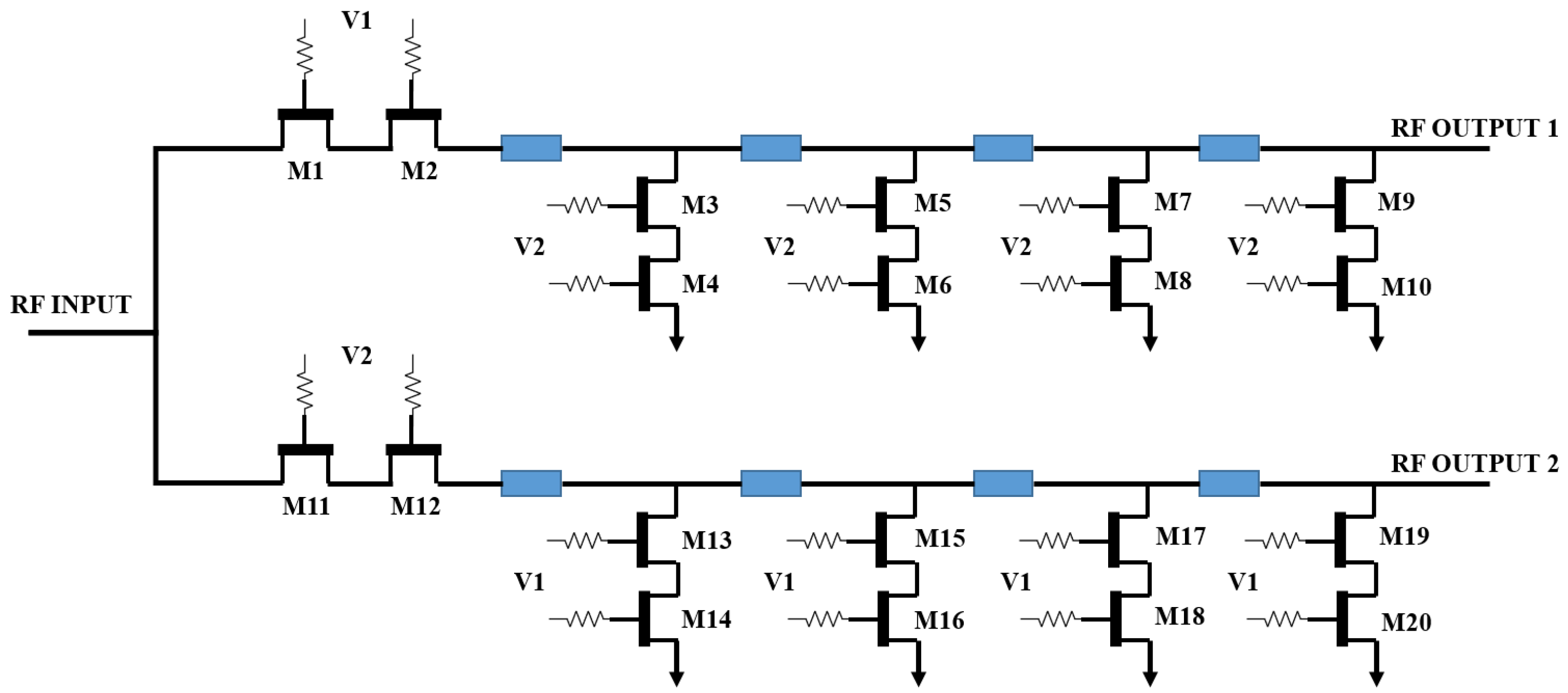
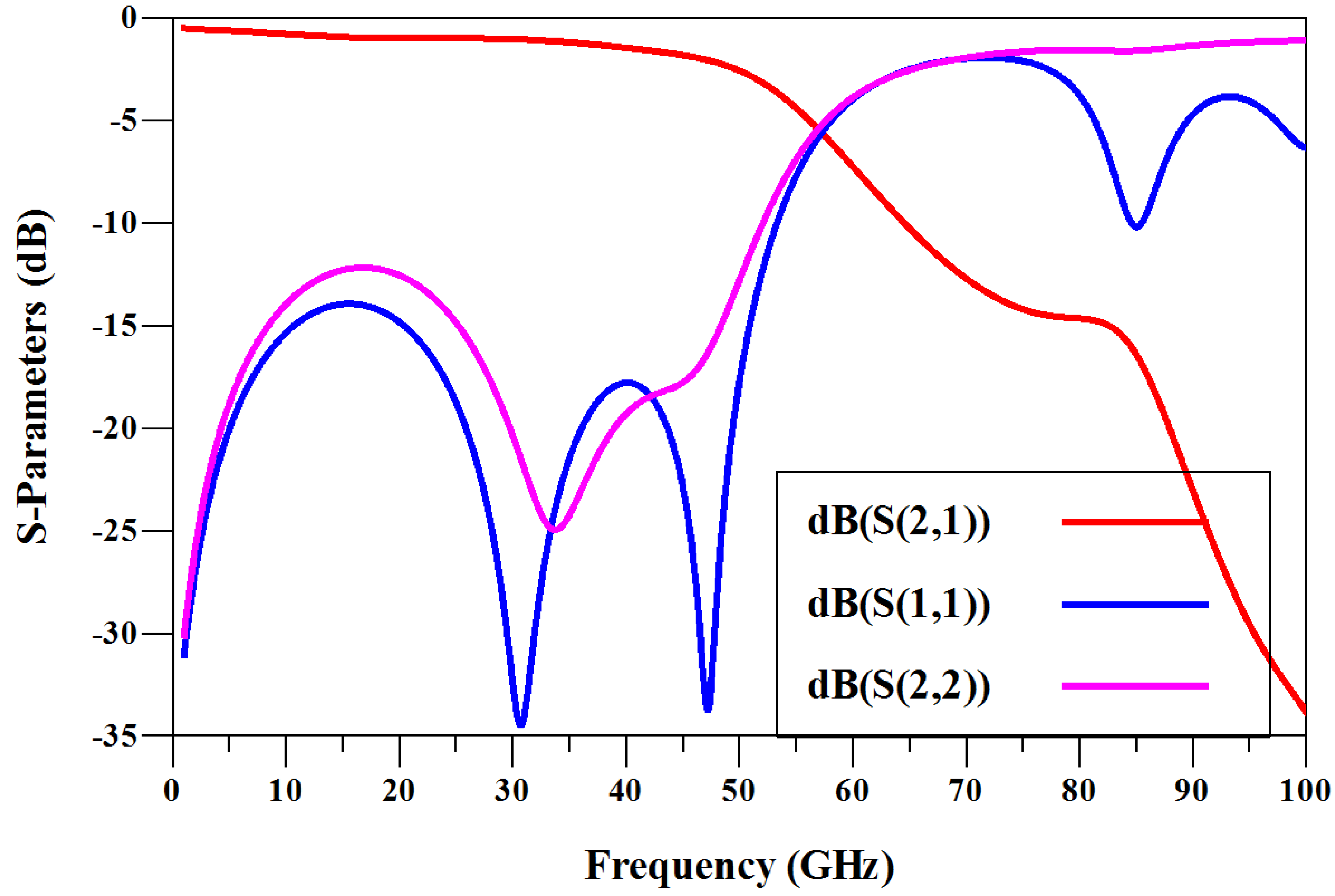

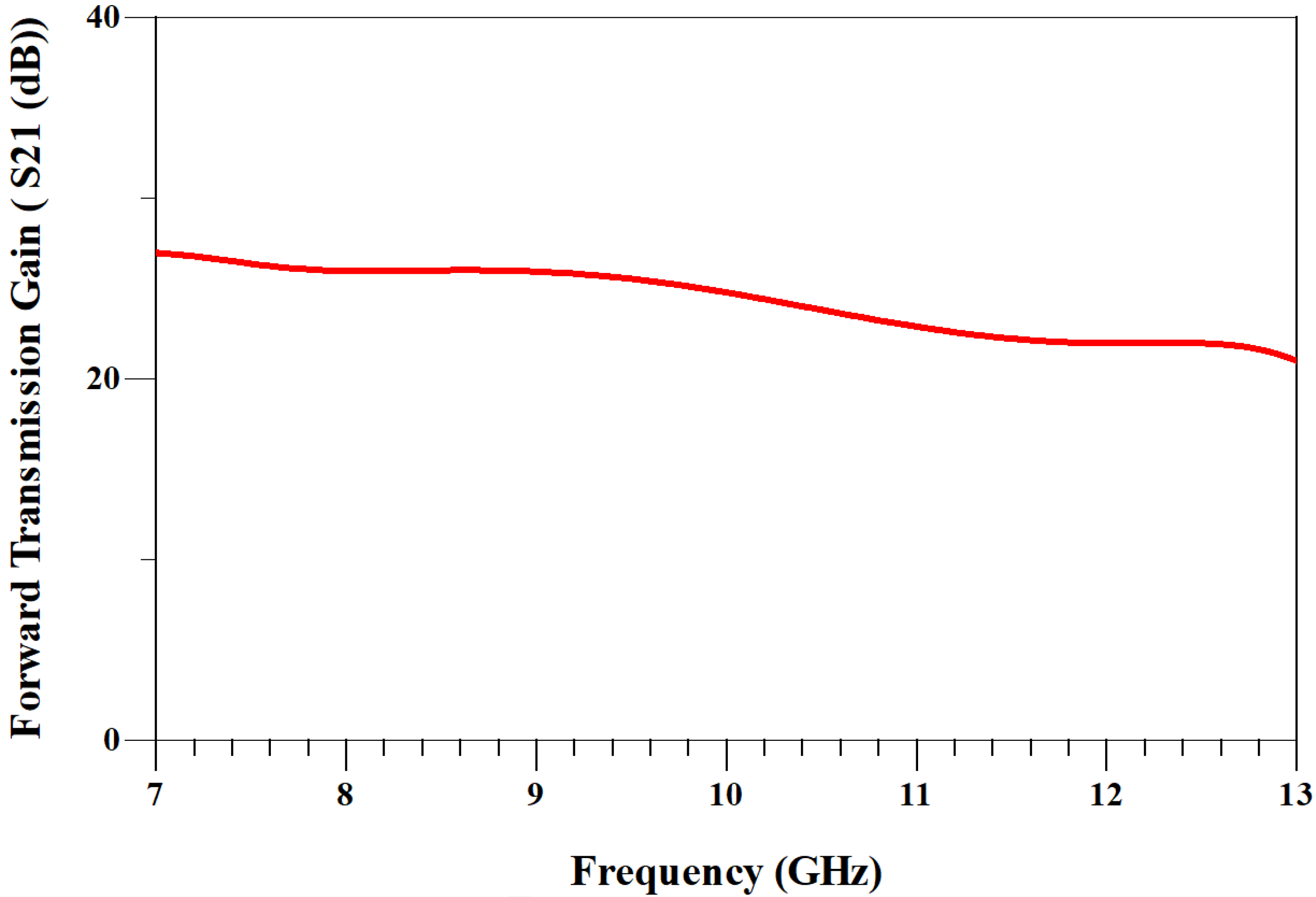

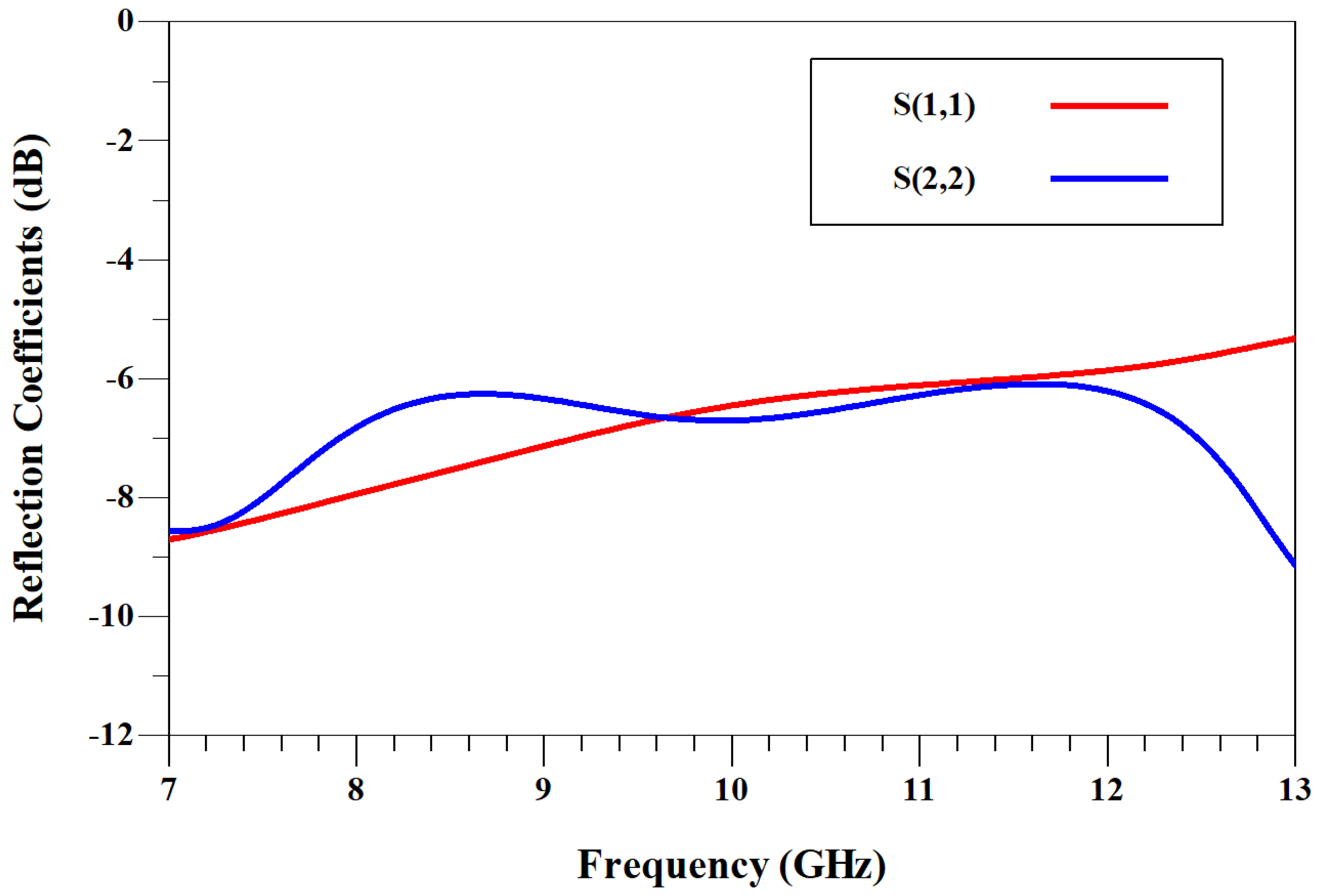



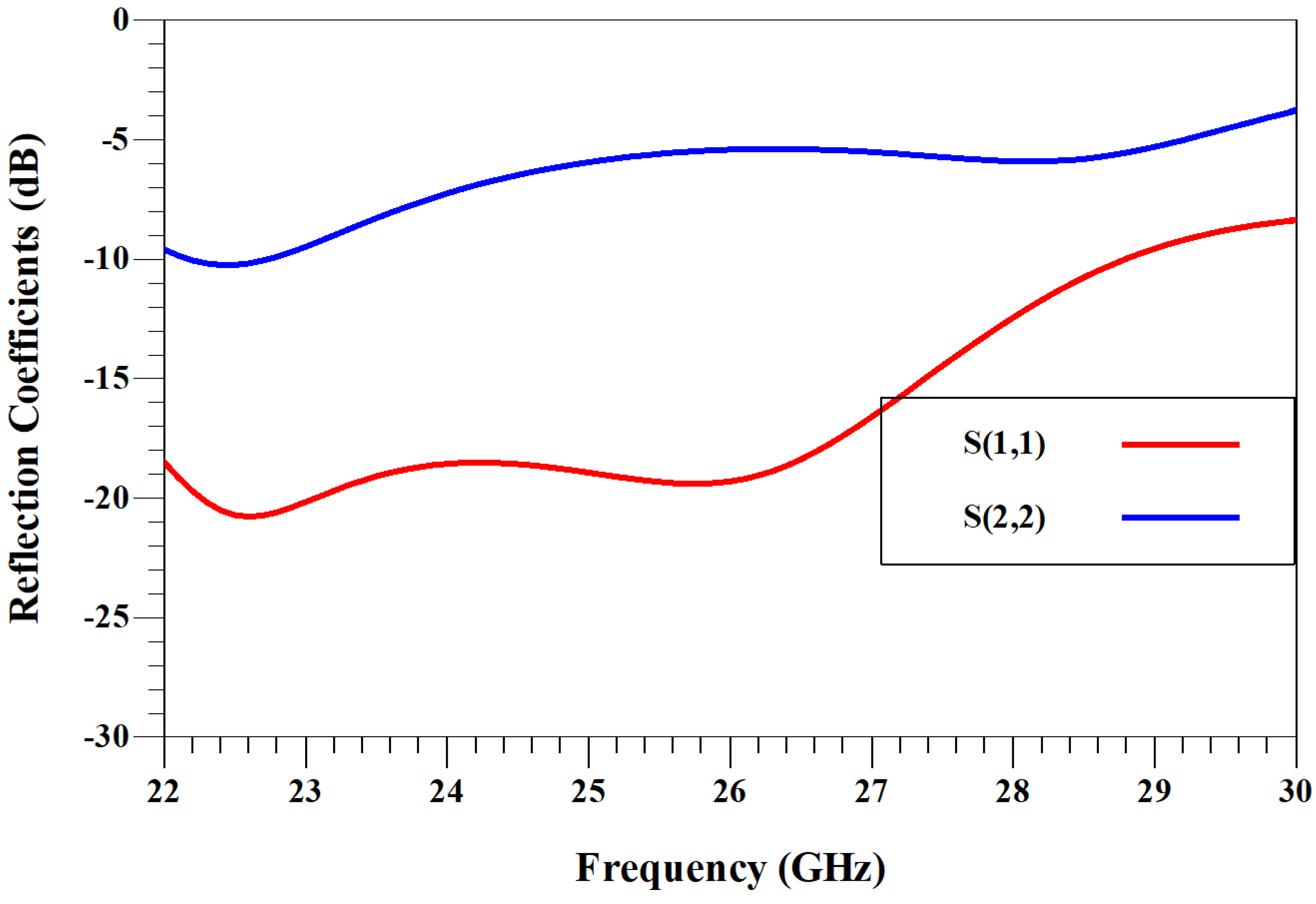
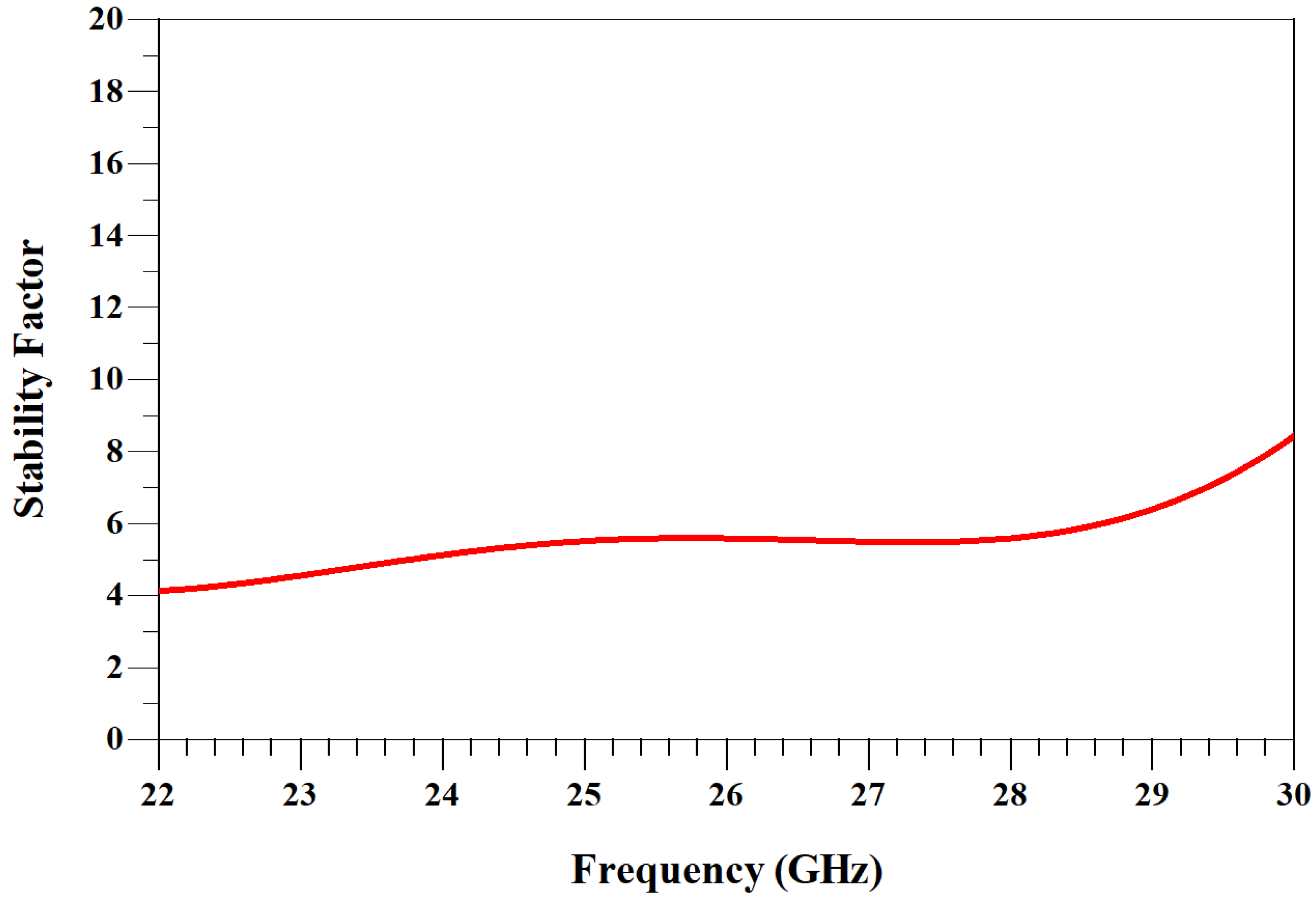
| Ref. | Process | Application | Freq. (GHz) | Gain (dB) | Noise (dB) | Power (mW) |
|---|---|---|---|---|---|---|
| [19] | 0.7 GaAs mHEMT | SATCOM | 7–11 | 30 | 1 | 62.2 |
| [20] | 0.65 CMOS | SATCOM | 9.35–10.65 | 27.8 | 1.8 | 4.68 |
| [21] | 0.13 SiGe BiCMOS | SATCOM | 6–12 | 21 | 1.7 | 100 |
| [22] | 0.65 CMOS | SATCOM | 8–12 | 15 | 8.4 | 110 |
| [23] | 0.18 CMOS | SATCOM | 6.4–7.4 | 12.5 | 3 | 19 |
| [24] | 0.1 GaAs mHEMT | SATCOM | 4–12 | 31.5 | 1.31 | 8 |
| [25] | 0.1 InP HEMT | SATCOM | 0.3–14 | 40 | 2.73 | 12 |
| [15] | 0.15 InGaAs pHEMT | SATCOM | 8–12 | 40 | 0.9 | 43 |
| Ref. | Process | Application | Freq. (GHz) | Gain (dB) | Noise (dB) | Power (mW) |
|---|---|---|---|---|---|---|
| [13] | 0.4 CMOS SOI | SATCOM | 20–22 | 3-17 | 8 | 2.82 |
| [26] | 0.25 SiGe | SATCOM | 19.7–21 | 0 | 5 | 0.24 |
| [27] | 0.4 CMOS | 5G | 26.5–29.5 | 0 | 4.2 | 0.9 |
| [28] | 0.28 CMOS | 5G | 25.8–28 | 30–69 | 6.7 | 0.4 |
| [29] | 0.13 SiGe | 5G | 27.5–29 | 30 | 3.7 | 3.3 |
| [30] | 0.65 CMOS | SATCOM | 17–21 | 16–34 | 5.4 | 0.93 |
| [31] | 0.15 AlGaAs-InGaAs pHEMT | 5G | 26-33 | 22.8 | 1.6 | - |
| [24] | 0.1 GaAs mHEMT | 5G | 25–34 | 24.2 | 3.04 | 2.8 |
| [25] | 0.1 InP HEMT | SATCOM/5G | 16–28 | 32.3 | 4.11 | 3.5 |
| [32] | GaAs pHEMT | SATCOM | 18–21.6 | 30.3 | 1 | 60 |
| [33] | 0.1 GaAs pHEMT | SATCOM/5G | 18–43 | 21.6 | 1.8–2.7 | 140 |
| [34] | 0.25 SiGe | 5G | 24–34 | 26.4 | 3.1–3.5 | 134 |
| [35] | 0.4 CMOS | 5G | 26–33 | 27.1 | 3.3–4.3 | 31.4 |
| [18] | 0.15 InGaAs pHEMT | 5G | 23–28 | 30.8 | 1.7 | 43 |
| Band | SPDT On-State | SPDT Off-State | ||
|---|---|---|---|---|
| Left Arm | 0 V | 2 V | −1.5 V | 0 V |
| Right Arm | 2 V | 0 V | 0 V | −1.5 V |
| Design Parameter | Requirement | 10 GHz | 26 GHz | 38 GHz |
|---|---|---|---|---|
| (dB) | −16 | −21 | −17 | |
| (dB) | −70 | −55 | −50 | |
| (dB) | −3 | −3 | −4 | |
| (dB) | −15 | −18 | −20 |
Disclaimer/Publisher’s Note: The statements, opinions and data contained in all publications are solely those of the individual author(s) and contributor(s) and not of MDPI and/or the editor(s). MDPI and/or the editor(s) disclaim responsibility for any injury to people or property resulting from any ideas, methods, instructions or products referred to in the content. |
© 2025 by the authors. Licensee MDPI, Basel, Switzerland. This article is an open access article distributed under the terms and conditions of the Creative Commons Attribution (CC BY) license (https://creativecommons.org/licenses/by/4.0/).
Share and Cite
Uko, M.; Ekpo, S.; Enahoro, S.; Elias, F.; Unnikrishnan, R.; Al-Yasir, Y. Highly Adaptive Reconfigurable Receiver Front-End for 5G and Satellite Applications. Technologies 2025, 13, 124. https://doi.org/10.3390/technologies13040124
Uko M, Ekpo S, Enahoro S, Elias F, Unnikrishnan R, Al-Yasir Y. Highly Adaptive Reconfigurable Receiver Front-End for 5G and Satellite Applications. Technologies. 2025; 13(4):124. https://doi.org/10.3390/technologies13040124
Chicago/Turabian StyleUko, Mfonobong, Sunday Ekpo, Sunday Enahoro, Fanuel Elias, Rahul Unnikrishnan, and Yasir Al-Yasir. 2025. "Highly Adaptive Reconfigurable Receiver Front-End for 5G and Satellite Applications" Technologies 13, no. 4: 124. https://doi.org/10.3390/technologies13040124
APA StyleUko, M., Ekpo, S., Enahoro, S., Elias, F., Unnikrishnan, R., & Al-Yasir, Y. (2025). Highly Adaptive Reconfigurable Receiver Front-End for 5G and Satellite Applications. Technologies, 13(4), 124. https://doi.org/10.3390/technologies13040124














